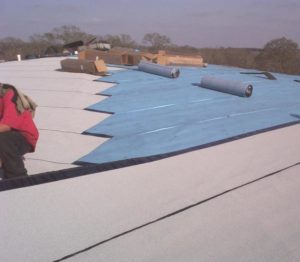Many homeowners today are choosing practicality over aesthetics. This is also true when it comes to choosing roofing material. Since conventional shingles are often beyond the budget of some homeowners, many are looking for an affordable alternative. One type of roofing that is gaining popularity over conventional material is rolled roofing. There is debate as to whether this is really a reliable alternative. Following is the information regarding rolled roofing.
choosing roofing material. Since conventional shingles are often beyond the budget of some homeowners, many are looking for an affordable alternative. One type of roofing that is gaining popularity over conventional material is rolled roofing. There is debate as to whether this is really a reliable alternative. Following is the information regarding rolled roofing.
What is Rolled Roofing?
Generally, this term refers to material used for the construction of a roof that is manufactured in rolls rather than in tiles or shingles. This applies to underlayment, eaves flashing and the finish itself.
The main ingredient used in the rolled material is similar to that used in asphalt shingles, although it does come in a much thinner layer so that it is pliable. To reinforce the asphalt, other materials are mixed in such as organic felt, SBS modified, reinforced fiber glass and others. The different types of material affect the durability of the sheet, such as its water resistance, tear resistance, thermal stability, and its flexibility. Due to the sheer number of choices, it is often best to consult a professional roofing contractor to determine which type is suitable for a particular location.
Different Types
- Saturated Felt – The saturated felt is designed as an underlayment between the decking and a thicker roofing material. It serves as additional insulation for the entire structure. While it is mainly composed of asphalt, it should not be used as the finishing material. Felt is mainly composed of organic material, such as wood shavings and recycled paper, which does not last long when soaked with water.
- Adhesive Flashing – Adhesive flashing can be used in several ways. Contractors use it to prevent water from seeping in at any intersection or projection such as vents, chimneys, valleys, and joints at vertical walls. It can also be used as an underlayment between the decking and the finishing. Because one side of it has an adhesive, installation is relatively easy and it can even be used temporarily to patch leaks and holes on the finishing.
- Smooth Finish – Smooth finish can be used as a temporary finishing layer. It is constructed from organic felt and soaked with asphalt to create a strong and waterproof sheet. To prevent it from sticking during installation, one side of the sheet comes coated with talc. It can be used as either an underlayment or a temporary finishing material. Because of the thinness of the layer, it should not be used as a permanent finish as it offers little durability and could develop leaks and tears in a short time.
- Mineral Finish – For homeowners who want a material that can be used for a long period of time, a mineral finish type of rolled roofing can be used. It is manufactured using fiberglass matting or organic felt along with asphalt. The mix is then rolled to create a thick sheet. One side of the sheet is coated with granules of rock and the opposite side has talc applied to prevent it from sticking. The combination of asphalt, fiber glass and organic felt makes a durable sheet that can be used as an alternative to conventional material. Mineral finish is currently being used in barns, sheds and other buildings. For additional durability, it can be layered twice, in an overlapping pattern, to achieve a tight seal.
Rolled roofing material can serve as an inexpensive alternative; however, it is important before installation to be sure that it is suitable for the location’s climate and weather conditions. This information is important to making a roofing material decision!
Are you looking for a Brazos Valley or Houston roofer who can install rolled roofing? Schulte Roofing can help customers decide if it is appropriate for their home and then install the chosen type of material on the roof!
